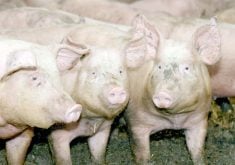When Michael Burgess graduated from high school in 1973, the caption under his yearbook photo noted that his ambition in life was to be a rancher.
“It’s all I’ve wanted to do,” said Burgess, who considers himself lucky to have fulfilled that ambition despite the challenges of the past two years.
He and his family ranch near Big Beaver, Sask., where they have a cow-calf operation and background calves.
The past two years have been difficult because of BSE and the loss of the U.S. market for Canadian cattle.
Read Also

The Western Producer Livestock Report – October 2, 2025
Western Producer Livestock Report for October 2, 2025. See U.S. & Canadian hog prices, Canadian bison & lamb market data and sale insight.
Like other cattle producers, Burgess has postponed improvements to his ranch, such as installing water pipelines to pastures, and has put off buying newer machinery.
He manages to find optimism through the efforts of cattle associations working to reopen the U.S. border and he said he gains added hope at this time of year from the sight of calves on pastures that are greening up.
However, he has had his share of sleepless nights, wondering where events will take the cattle industry in Canada.
One of his worries is what will become of younger livestock producers who were not well established before BSE was confirmed in an Alberta cull cow in May 2003.
“There’s a lot of young operators that work very close to the line,” Burgess said on a morning when his main chore would be pulling cattle off pasture to brand calves.
“I’m concerned for them and, well, concerned for ourselves, too. We’re always on the edge of a drought down in this country.”
Burgess has watched the price for his cull cows dwindle, prompting him to keep more of them on the ranch for breeding rather than shipping them to market.
Meanwhile, he watches with envy as American cattle producers take advantage of the peak in the cattle price cycle.
“That’s kind of what hurts the most,” Burgess said. “We’ve missed the peak of this cycle and that’s what carries us through.”
Belt tightening is something a lot of cattle producers have had to do in the past two years, including those who raise breeding stock.
Larry Dimler, a purebred cattle breeder at Grenfell, Sask., said the demand for his bulls and heifers is about half what it was before BSE. Despite efforts to manage costs, he said his loans are mounting because of the weakened market.
“I guess people just haven’t got the money. Old bulls aren’t worth nothing so they just keep them till they die, sort of thing, instead of purchasing a new herd sire.”
Two years ago, Dimler didn’t believe the border would stay closed as long as it has. He still has his fingers crossed that things will get better.
“I didn’t think one animal (with BSE) would be a big deal, but it sure has become that.”
Meanwhile, feedlot operator Art Petkau of Morden, Man., describes his outlook as “pretty pessimistic,” noting he has suffered a huge equity loss in the past two years.
He said feedlots fared well in the first year after BSE was confirmed, largely because of government support programs. It was in the second year that the losses began to add up.
“The first year with the government payments helped a lot and then we were optimistic that the border would open, but it didn’t open and then there were no payments, or virtually none. The big loss came in the second year of BSE for us. We were too optimistic buying feeder cattle.”
Petkau said the failure of the border to reopen on March 7 has added to skepticism in the cattle industry. Like Dimler, he would not have believed two years ago that the U.S. border would still be closed.
“It all hinges on the border opening.”
















